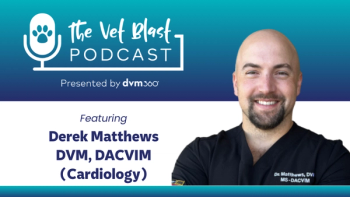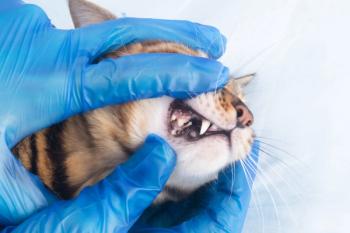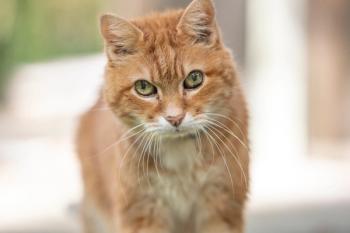
I survived an outbreak of virulent feline calicivirus
I'll never know for sure which cat first brought the disease to my clinic. But I know where I saw it first.
I don't know for sure which cat first brought the disease into my clinic. But I know where I saw it first. The cat belonged to one of my best clients, a woman with multiple pets who accepted my recommendations and came in for her follow-up appointments. This was a woman who did the best for her cats ...
Patient One
This client brought in a new purebred for a spay. A few days later, she came back—the cat was ravaged by fever, lethargy, and limb edema. I couldn't believe it. I've almost never seen a major surgical complication after 18 years of spaying and neutering cats. We admitted the patient into the main hospital. She was so sweet that team members coddled her and carried her around the clinic. But the cat got worse, not better, and the owner opted for euthanasia.
Photos by Michael Salerno Photography
We didn't test that patient for virulent systemic feline calicivirus because no one suspected it. I didn't think the situation would get worse, but it did.
Patients Two, Three, and Four
This client soon called to tell us her other three cats were sick. Luckily, they weren't in as bad of shape as the first, and we treated them as outpatients. They lived.
Now we highly suspected that our clinic had a bug. But what was it? I'd never seen anything like this before. We took tissue samples and oral swabs and sent them out for virus isolation to Cornell University and the University of California-Davis. Those tests—and frantic e-mails to university researchers—brought back unanimous agreement: Our clinic had been exposed to virulent systemic calicivirus. One researcher at UC Davis said he'd lost most of his research cats to an outbreak. It was a strain that routine feline vaccination didn't protect against.
I don't think the virus originated with my A-list client. In retrospect, I believe another was to blame: a frequent visitor to humane societies with her own home "shelter" and a tendency to hoard cats.
But retrospect didn't help me in the moment. More of our recently treated patients were getting sick.
Patients Five, Six ... and on ... and on ...
We were racking up more patients with fever, limb edema, and anorexia. There was a 12-year-old diabetic cat that had been in the hospital for a blood glucose curve, cats that were in for routine vaccinations and boarding, cats being treated for renal disease, our two blood donor cats, and an associate doctor's cat at home. They were all sick with the same symptoms. We did more testing and found out for sure that we had virulent systemic calicivirus.
Then the cats started dying, one after another. Or they became so sick that their owners sorrowfully opted for euthanasia. Conventional treatments didn't work: not intravenous fluids (if you could even get a line in), parenteral antibiotics, or corticosteroids. The cats continued to run high fevers and developed painful oral ulcerations and limb edema. Vasculitis caused their skin to slough off wherever we stuck them with needles. Even the specialists didn't know how to save the cats that had contracted the virus.
Eventually, we euthanized our two hospital blood donors when their temperatures hit 105 degrees and they stopped eating. These were cats it seemed we'd lived with forever. I didn't want them to die like that.
Then we euthanized my associate's cat—young, portly, and beautiful.
Closed to cats
As our patients began inexorably and relentlessly dying, we made the difficult decision to close our hospital to cats for one month. That meant we were closing our doors to up to 35 percent of our income. But what choice did we have?
The university specialist told us to disinfect everything with bleach and throw out anything that wasn't nailed down or cleanable in the autoclave. Unlike its milder counterpart, this calicivirus strain is highly contagious, spread by fomites, and difficult to eradicate.
We threw out endotracheal tubes, drapes, and towels. We resterilized everything and switched to a different disinfectant to make sure we'd cleaned up twice. We threw out equipment and supplies. It was costly. And necessary.
The remaining five
Five sick cats were left. We moved them to a separate building that serves as an isolation unit behind our clinic. A single technician and I didn't even enter the main hospital on certain days during the three weeks we were treating these last five patients. I labored over these deteriorating patients every day. I had already watched 12 cats die screaming in pain, and I was afraid these five wouldn't make it either.
There had to be a way to save them. I couldn't force-feed them because of the oral ulcerations—the cats would drool or spit out the solution. One cat's tongue looked like it would actually slough off. So we tried something unconventional. We anesthetized the two youngest cats despite their debilitated condition and placed esophagostomy tubes. This helped them keep their food and medicine down, so we did the same thing with the remaining three cats.
It was over
We saved those last five cats. But it was small solace—we had lost so many. We finally knew how to manage this fatal disease, but there were no more patients. The hospital was clean.
Today, we strongly recommend that all clients vaccinate their cats against virulent systemic calicivirus, especially owners who volunteer at or routinely visit the local animal shelter. Also, we've changed our disinfection protocol and the way we handle suspicious, possibly infectious cats. We used to keep some of them in isolation in our main hospital. No more. All hospitalized respiratory cases go straight back into the isolation ward.
The cost of this outbreak was huge. It cost us in doctor hours, diagnostics, long-distance phone calls, and, worst of all, patient lives. We cared for the sick cats for free, and we lost income during the month we were closed to cats. Client trust took a hit, too. An outbreak such at this is hard to explain. I know, because I had the job of calling clients several times a day, every day, to update them on their pets' condition. Most were understanding, knowing that we were doing everything in our power to save the cats' lives and that this was beyond our control.
Owners of cats that were infected at our hospital might have been angry and were certainly hurt, but they saw that we were doing our best. One couple, with both of their cats sick with the disease, came every day to visit and saw how their pets improved with good care. My team was deeply fulfilled when they saw that their hard work turned these cats around and that the clients were grateful.
This was a real trial for us, but I learned how lucky I was to have such a good group of team members. They pulled together to bleach walls and floors, sterilize instruments, and come up with creative ways to make sure nothing from the isolation unit ever came into the hospital. One of my technicians even volunteered to take the laundry home from the isolation unit. If she hadn't, we would have continued throwing everything out from that area every day because we couldn't bring it into the clinic to clean.
Virulent systemic feline calicivirus isn't common, but if it does show up, it can be devastating. Stay on top of disease prevention and disinfection at your facility. Don't act too late to stop an outbreak.
Look online
About the Author
Dr. Susan Adams-Conley is owner and president of Bellingham Animal Hospital in Bellingham, Mass., a small animal hospital with four full-time veterinarians.
Newsletter
From exam room tips to practice management insights, get trusted veterinary news delivered straight to your inbox—subscribe to dvm360.




